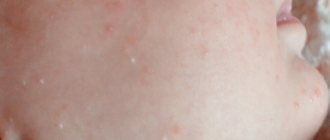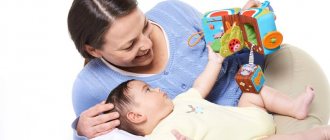Many mothers who want to help their baby develop as fully as possible have heard that various pictures are used to develop vision in young children. On this page we have selected a collection of black and white pictures for newborns for you to print. If you already know what these are and how to use them, feel free to scroll to the end of the article, where you will find a link where you can download and print a selection of 100 educational pictures for newborns. And if you want to understand why children need to look at patterns at all, read the short preface.
Kids see this world differently than adults. Many structures of the eye (for example, the retina and ciliary body) are not yet fully developed at the time of birth. And the brain, in which only about 15% of neural connections are formed at the time of birth, cannot yet process such an amount of information. At first, all that a newborn can see is the mother's face, the nipple (the areolas of your nipples most likely darkened during pregnancy, and this is no coincidence) or the nipple on the bottle. But gradually the baby grows up, and more and more details of this amazing surrounding world are revealed to him. Mom and dad can help the baby develop by stimulating him with pictures that he can already see. It’s worth starting to teach your baby to recognize objects with the simplest forms. As a rule, these are black and white contrasting drawings depicting geometric objects, repeating patterns or large schematic objects. Such pictures can be hung where the baby spends time free from sleep, as well as where you lay him on his tummy, so that it is more interesting for him to learn to lift and hold his head. As the child grows up, the pictures he looks at should become more complex. Here is an approximate plan for the “looking around”:
Is it possible to check a child’s vision yourself?
Upon reaching 3 years of age, a child’s vision can be checked at home. The Orlova table is the most popular home examination method. The table does not show familiar letters, but images of animals, since at 3 years old a child cannot yet know the alphabet.
The Orlova table is a method of testing vision, but for this you need to make printouts of the table, then place it on the child’s eye line in a lighted room.
To check the functionality of a child’s vision at home, you must use the following recommendations:
- Before starting a vision test, you need to familiarize your child with the table and ask him to list all the pictures on it. This must be done, because this way the child will understand what is required of him.
- Testing vision at home causes eye fatigue in children much earlier than when examined by a doctor. In this case, it is better to start the study from the top of the table, showing only one picture from the row.
- During the test, one eye must be closed.
- It is necessary to ensure that the child does not squint and can give the desired answer within 5 minutes.
To check the level of visual acuity of a schoolchild, a different method should be used. All school-age children know the alphabet, which means that Sivtsev’s table can be used. It is the most popular for vision testing in medical institutions; in addition, it gives fairly good results. The table has the same structure as Orlova’s table, but instead of pictures there are letters. In this case, it is used according to the same principle:
- ask the child to move away to a distance of 5 meters and cover one eye with the palm of his hand;
- after that ask him which letters are in the 10th row;
- if the student answered everything without errors, then there are no deviations;
- eyes are checked one by one.
You can make a similar table yourself by printing it on good quality paper. An A4 sheet of paper will do.
How does an infant see?
As you know, the sensory organs of infants function somewhat differently than those of adults. This is due to the complex and lengthy processes of adaptation to the surrounding world that a small person goes through in the process of his development and growth.
It is especially important to diagnose the existing pathology in the first few weeks of life: this will greatly facilitate the further treatment process
Features of the visual system of newborns
Unlike adults, children in the first days of life see the world completely differently. This is determined by some features of the development and structure of the extraocular muscles, eyeball and lens in a child:
- spherical eyeball;
- thin and delicate cornea, rich in blood vessels;
- the weight of the eyeball is no more than four to five grams;
- low refractive power of the cornea;
- tear ducts that are not fully formed;
- lack of tear fluid in the canals for the first few weeks of life;
- a small amount of melanin pigment in the iris;
- narrow pupil (no more than two millimeters in diameter);
- greater curvature of the lens, which leads to distortion of vision and the formation of an “inverted” picture;
- the presence of ten layers of the retina (an adult has six).
Due to the structural features of the children's visual system, it is very vulnerable to external influences from environmental factors. That is why in the first days of life, babies quite often suffer from various inflammatory and infectious eye diseases (conjunctivitis, keratitis), which can seriously affect the quality of vision in the future.
Video: how newborn babies see the world around them
Children's vision in the first days of life
Immediately after birth, the visual function of the newborn is significantly limited. He can only see thirty degrees to the right and left, ten degrees up and down. Objects located more than one meter from the eyes will not fall into its field of view.
In the first days of life, a newborn sees all objects as blurry spots.
The visual acuity of an infant in the first days of life is much lower than that of an adult. This is explained by the high refractive power of the lens, which makes all children physiologically farsighted. The macula on the retina (the area of greatest visual acuity) is less than sixty percent formed at the time of birth.
Changes in a child's vision in the first month of life
Ten days after birth, the baby already becomes capable of fixing his gaze on a moving object for a few seconds. Doctors usually recommend starting the first training with cards at this time. Month-old babies perceive black and white patterns and drawings with large pictures better, since the retinal cells that perceive colors are not yet fully formed.
Vision of a baby in the second or third month of life
By the second month of life, the baby independently fixes his gaze on an object for a long time, his gaze becomes more meaningful. The baby already reacts more vividly to changes in faces and surroundings. When traveling in the arms of an adult, a child who already knows how to hold his head actively looks around and tries to find an object that is slipping out of sight.
After three months of life, the color-perceiving apparatus of the retina begins to actively develop. The child likes bright and colorful toys more than black and white ones. The baby also begins to become interested in the shapes of objects: he runs his finger over them, draws patterns in the air. By six months, the baby tries to independently explore the world, actively examines objects in the environment, fixes his gaze on them and asks his parents to give him certain toys.
Exercises
- The baby should be shown one image, remove it from the baby’s field of vision for 30 seconds and replace it with a new one.
- You should prepare in advance large images of a butterfly and a Christmas tree of the same color and show them alternately.
- You need to cut out and paste onto paper in A4 format pictures of two flowers of the same shape and size with large petals, but differing in color.
Demonstration of images should take place in a playful way:
- One image is shown, then you should take a white sheet of paper and cover half of the image with it, then open the picture.
- After the demonstration, the educational material is also covered with clean paper, but unlike the first step, the illustration should be completely open.
- A kind of “deck” of images is prepared, alternating with white sheets of paper. Every 20-30 seconds you need to change pictures. Usually kids are surprised by such a kaleidoscope of materials of different shapes and sizes.
- You should take a sheet of paper and start moving it like an airplane in front of the child’s eyes, remove it from his field of vision and show it again, but from the opposite side. After several such educational games, the child will look in the required direction and wait for a sheet of paper to appear.
Development
The anatomical and physiological features of vision development in children of the first year of life (AFO) will tell parents what and how to do in order to promote the development of the baby’s visual function. If the baby was brought from the maternity hospital and placed in a darkened room with little sunlight, then all stages of vision formation may occur with a significant delay
For newborns, it is very important that the room is bright, that there are no bright sources of light or mirrors near the crib. Access to the crib should be from all sides so that the baby gets used to looking at people and objects on both the right and left sides.
In the first days and even weeks, the child does not need any toys, since he will not really see them anyway. But by the 3-4th week of life, you can attach a mobile to the crib or hang rattles. The main requirement that will help maintain the health of your baby’s eyes is the distance from the face to the toy. It should not be less than 40 centimeters.
From one and a half months, the child can be shown black and white pictures consisting of simple geometric elements. They can be found on the Internet and printed on sheets of A4 format. Such simple activities contribute to the development of the optic nerve and eye muscles, and the child learns to perceive contrasting images.
At first it is better to use sounding toys; by 3 months you can switch to silent toys. The first rattles should not contain too many elements of all the colors of the rainbow. It is better to place red and yellow elements in the center, and move blue and green ones as far as possible to the sides; the baby will learn to distinguish them much later. The size of one element that a baby’s eyes can discern more or less clearly should not exceed 5-6 centimeters.
Toys must be safe, because starting from 4-5 months, the baby must pick them up in order to form stable connections in the brain between tactile sensations and the shape and color of objects that are seen with the eyes. As soon as the baby learns to crawl and sit, you need to give him freedom of movement. Stereoscopic vision will develop more quickly if the toddler can easily perceive the space around him. In this case, it is imperative to take all safety measures so that the baby does not get injured.
Walks are important not only because the child breathes fresh air outside, but also because sunlight is very useful for the formation and development of the eyeballs and other structures of the visual organs.
Where to conduct classes?
The answer is simple: anywhere!
- The easiest option is to hang photographs and pictures near the baby's crib.
- You can spread educational material throughout the children's room or apartment.
- Attach the images with magnets to the refrigerator, stick them to cabinets or hang them on the wall.
Not only cards, photographs and illustrations are suitable as educational material, but also black and white or multi-colored cubes, rugs, rattles, balls, books, collages and many other educational sources.
Regular diapers are familiar to everyone, but there are also reusable diapers. How to use them and whether they are convenient, read on our website.
Why green snot is dangerous in newborns and how you can cure it, read in this material.
They can be shown to your child during a tour of the apartment with a demonstration of all kinds of objects, during a family vacation or while chatting with friends.
A newly born human also needs good education and development of his horizons. Displaying images, ranging from simple black and white to complex multi-colored ones, stimulates the vital organs of the visual system and improves children's intelligence.
Note to parents.
Ophthalmologists regularly check vision in children, but this does not mean that responsibility for the child’s health is removed from the parents. It is the parents who must closely monitor the child’s vision in the periods between these checks. If parents notice a deviation that is not typical for the child’s age, they should immediately consult a doctor without waiting for it to worsen.
Given that every child is different, some may develop vision faster than others. But such deviations as severe squint, when the child’s eyes constantly squint, which is not typical for infants, redness of the eyes, abnormal reaction to light - all these are unfavorable signals that need to be noticed in a timely manner. The sooner a deviation is identified, the sooner the doctor will take action, and the greater the chance of correcting the impending problem.
It should be understood that at such an early age, inactivity for one to two months can be fatal to the child’s vision. This is why routine eye examinations should not be neglected, even if outwardly it seems that everything is in order.
When does a child begin to focus his gaze?
At 7 months of pregnancy, the fetus's vision is almost completely formed. What remains is the development of the brain center responsible for visual perception, which begins to process pictures from 4 months of age after the birth of a child. Therefore, up to four months, babies can see the world only in a two-dimensional image. From this age, the toddler is able to focus his gaze on stationary and moving objects.
How newborns see objects has been known for a long time; all children develop according to a standard scenario. After childbirth, due to compression of the skull, swelling and swelling of the eyelids, the baby perceives the surrounding space vaguely. Closer to one month of age, the baby sees objects in black and white. As they grow, their arsenal of visual perceptions is replenished with a variety of colors, first with red and yellow at the age of about 3 months, later with green, blue and other tones.
How do babies see at 1 month?
Parents are often interested in how one-month-old newborns see, how can they understand that the development of visual perception is developing normally? At 1 month, the main objects that the baby distinguishes are sources of bright light and the mother’s face. The baby's eyes wander around the room because it is still difficult for him to focus his gaze on surrounding objects.
What colors does a baby distinguish at 2-3 months?
At the age of two months, the child, in addition to white and black, begins to distinguish red, orange and yellow colors. A three-month-old toddler already follows moving objects with his eyes, perceives the absence and presence of light. But it cannot yet capture the visual image in wide format. A 2-3 month old baby sees all surrounding objects in two-dimensional space. A newborn child begins to see normally from about five months of age.
Improving visual function from 4 to 6 months
After three months, starting from the fourth, green and blue are added to the palette of colors that babies distinguish. The visual parts of the brain and the central zone of the retina of a child at 4–6 months provide the ability to see a three-dimensional image with many shades of colors. Babies at this age are actively exploring the world around them, looking at objects. Toddlers turn their heads in all directions and can fix their gaze on both stationary and moving objects.
Below the article you can download black and white and contrast pictures for newborns.
Why do we need black and white pictures for newborns?
You can make your own mobile from them, as well as cubes.
You can study with your baby using these manuals from birth.
Black and white pictures for newborns perfectly stimulate vision development in the first months of life.
Early childhood gurus such as Cecile Lupan and Sarah Brewer wrote about them in their book Superbaby.
In the first days of life, a child's vision is not as sharp as that of an adult.
It distinguishes objects better at close distances, and black and white images are more noticeable than color ones due to the structural features of the retina during this period.
The period from birth to six months is very important for the development of a child’s vision, because it is during this period that the eyeball, the pathways leading from it to the brain, and the areas of the brain responsible for receiving and processing visual information are formed most quickly and intensively.
Psychophysiologists speak of this period as critical for the formation of the visual system.
It is the first 6 months of a child’s life that are the most favorable for external stimulation and development of the visual system. As a result of such exercises, visual functions are significantly improved: light perception, visual acuity, color perception, contrast sensitivity, field of view.
Classes can be carried out on a changing table, in a crib, on a bed, etc., but it is better that the light source is behind the baby’s head.
It’s worth starting with the simplest lines and keeping an eye on the clear black/white contrast.
In the first months, it is important to teach your child to look at pictures, focus his vision and follow objects.
Where to hang black and white pictures
- in the crib,
- stick on the walls,
- hang on the refrigerator,
- into big cubes
- make cards, collages or a book, show it to the baby one by one,
- a ball or mobile above the crib with drawings,
- educational mat
How to use black and white pictures for newborns
Show your baby pictures while you walk around the apartment with him, feed him, or lay him on his tummy. A visually rich space (and constant visual stimulation) has a direct link to baby's restful sleep. Don't show your baby too many pictures at once and watch the reaction. If he doesn’t focus his eyes on the drawing and shows no interest in it at all, don’t be upset (everything has its time). Practice tracking: catch your eye on the picture and move it slowly left and right, up and down, then over time we complicate the trajectory: in an arc, diagonally, in a circle. Use while lying on your tummy and crawling
The baby tries to raise his head higher and higher, and it will be interesting for him to see something there that catches his eye. Attract and switch attention, calm.
Useful tips
change
the image every 3 days
. If you like the picture, you can leave it for a longer time.
Distance from the child’s eyes to the image at the age of 10 days – 1.5 months – about 30 cm
. The size of the drawings is better than A4 or maybe A5 (a quarter of it).
From 3 months, images can be replaced with colored, complex and “hygienically clean” ones - the baby will begin to drag them into his mouth.
How to do:
- You can draw any pictures by hand.
- Make a mobile with your own hands from cubes. We print the pictures from the pdf file (there is already a ready-made layout for the cubes), cut them out, glue them in the shape of cubes, hang them on a ribbon (then it’s up to your imagination)
Where to hang it?
Such pictures can be hung in absolutely any place a child can see: on walls and doors, a refrigerator, a crib.
Often simple black and white images are used in the design of educational rugs, mobiles, cubes, books and pillows.
Much of the above can be glued or sewn yourself by printing suitable pictures from the Internet or simply drawing them by hand.
Developmental activities
Black and white pictures help newborns learn about the world around them
Scientists say that all newborns have the same number of neurons, which begin to interact with each other after birth. The more a child learns about the world around him, the more connections are established between neurons, which leads to more intensive development of the baby.
According to statistics, children who were taught lessons on black and white pictures under the age of 4 are calmer when awake, their vision is well developed, they are more concentrated and attentive.
The child will determine the duration of the lessons independently. By his behavior, the mother will understand that her baby is tired and no longer wants to look at the images. He will lose interest and begin to mope. Already at the first such manifestations, classes must be ended, since subsequently the child will completely lose interest in the images.
You can work with your child several times a day, periodically changing the images in the pictures. You can play such games in the first 3-4 months after birth, and then add additional bright colors to the black and white pictures. During this period, the baby’s vision is reconstructed and is already able to distinguish some colors other than black and white.
It is worth remembering that in the first stages of life a child is very curious and the more intensively her baby will develop, depending on how often and excitingly the mother engages with him.
Black and white pictures help a child not only learn about the world around him, but also have a fun time.
The video will present various educational activities with newborns:
24 Oct 2015 Yuki 982
Training rules
Educational games should be carried out in a calm and relaxed environment.
The best time is after feeding the baby. Both mother and baby should be in a good mood.
Visual activities should be alternated with the development of hearing and touch. During lessons, you must talk to your child, smile, look him in the eyes, and give him the opportunity to touch and play with the material on display.
If the baby is not in the mood, under no circumstances should you insist on classes. It is best to choose a more suitable time.
The main thing when displaying images is a sense of proportion: in no case should you overdo it with the material shown and show many sources at once. It's better to limit yourself to one picture. Otherwise, the child will develop a feeling of disgust, indifference and isolation.
Developmental materials should be shown to the baby at a distance of 30 cm, not forgetting about a good mood and smiling, since emotional contact with mom, dad, grandparents is no less important when communicating and teaching babies.
Experiment with two different images
A group of scientists led by Frank Tong in 1998 studied the effect that occurs when looking at two different images simultaneously. They called it binocular rivalry. The visual signals of the left and right eyes “compete” with each other.
When paintings are superimposed on each other, one dominates the other and we cannot focus on anything specific. Whether we like it or not, vision will jump from one to another, and it is difficult to understand what exactly we are seeing
Although it's just a face and a building.
You can repeat the experiment yourself. To do this, you need to make a tube from a newspaper and look through it with one eye into the distance. You need to bring your palm to the second eye, leaning it against a tube of newspaper. Wait 10 seconds and slowly move your palm away, continuing to look into the newspaper tube. You will clearly see surrounding objects through the round hole in your palm.
conclusions
- If we simultaneously observe two closely located images for a short time, we will not be able to understand what exactly we are seeing.
- When overlaying images on top of each other, you need to make one more contrasting than the other.
Possible developmental disorders, their causes
A newborn's vision may develop with pathologies. They can appear for one of three reasons:
- Heredity. A child is at risk if his parents or grandparents have eye problems (an anamnesis is collected according to the parents’ description at the first visit to the pediatrician). Possible diseases are glaucoma, cataracts, color blindness, corneal opacities, etc.
- Congenital. They may appear during fetal development due to a negative effect on the fetus (viral or chronic diseases of the mother, poisoning, etc.).
- Purchased. They appear after childbirth due to external causes: injuries, poor nutrition, improper hygiene, infectious and viral diseases, etc. This also includes problems due to prematurity.
Any of the above problems can be found either immediately after birth or appear some time after it. In babies at risk due to genetics or prematurity, this is why scheduled appointments with the ophthalmologist are scheduled more often. If vision is normal within a year from birth, the risk of pathologies in this case is reduced, but does not completely disappear.
Excerpts from the book "Super Baby" by Sarah Brewer
Vision plays a decisive role in the development of a child. Seeing various objects in front of him, the child wants to find out what they are. The desire to reach for objects, crawl, and roll over comes from natural curiosity and the desire to explore everything that the child sees around him. In the first two months of his life, he sees best at close range.
A newborn baby's field of vision is more limited than an adult's. Presumably, the child’s field of vision includes objects that are no further than 30 degrees to the left and right of him, 10 degrees above and below and at a distance not exceeding 90 cm from his eyes. When he suckles, he naturally focuses his vision on objects located at a distance of 15 - 20 cm.
Usually by two weeks the baby begins to recognize the faces of his mother and father. His visual acuity is 10 to 30 percent less than that of an adult, so it is more difficult for him to recognize fine lines, which he sees as a blurry gray mass. The retina of the human eye contains photoreceptors such as rods and cones. Rods are cells that are sensitive to low light and movement and can only distinguish shades of black and white.
Cones are cells that are responsible for daytime vision and allow you to see different colors and shades. Newborn babies enjoy contrasting black and white pictures more than color ones because at this age their rods work better than their cones. All other colors are seen by them as shades of gray.
Since black and white colors are most easily recognized by children, the use of black and white pictures stimulates the formation of connections between neurons in the cerebral cortex, develops attention, stimulates natural childish curiosity and calms down during periods of overstimulation. Newborns also like straight or broken lines more than curved or wavy ones.
In addition, they are attracted to simple, schematic images of human faces.
Also, newborns prefer straight or broken lines rather than curved or wavy ones. In addition, they are attracted to simple, schematic images of human faces.
By the sixth week, the baby can clearly focus his vision on different objects at a distance of about 30 cm from him. He is especially attracted to simple images of faces and concentric circles in different variations. The child studies the outer edges of the drawings more closely than their middle.
The human brain is fully formed during intrauterine development. The number of neurons does not increase after birth; the brain develops due to the formation of new connections between neurons. The number of contacts between neurons in the area of the cerebral cortex responsible for visual information begins to gradually increase in the first 2 months after birth.
Between 2 and 4 months, the number of connections between neurons begins to grow sharply and increases by no less than 10 times. At this time, the child’s vision improves sharply, he can follow objects with his eyes and turn in the direction where the sound comes from. He begins to like more complex designs, rounded lines and shapes, rather than straight and broken ones. From the child’s behavior you can see that he remembers what he saw.
Many children begin to distinguish colors by two months because the cones in the retina begin to work. But until three months of age, they presumably don't see blue as well as yellow or red.
By four months, the child distinguishes all colors and can focus his vision on both near and distant objects. He enjoys watching parents and other people, especially children
He still prefers curved lines to straight lines and pays attention to more complex designs. At 4 - 5 months the child begins to reach for objects that he sees; at 7 - 8 months he can grab objects and try to put them in his mouth
A child whose visual perception is constantly stimulated is usually calmer and more alert while awake than a child who is deprived of such stimulation. The number of connections between neurons in the visual cortex peaks at 8 months of age, remains highest until four years of age, and gradually decreases by half over the next five years.
Consequently, binocular vision develops during the first four years of life and is fully formed by the age of four. Visual acuity is practically established by the age of five and is finally formed by the age of ten.
Features of vision of a newborn
The anatomy of the structure of the eyeball and the areas of the brain responsible for processing the visual perception of a newly born human being is very different from the structure of the eye of an adult.
For the first 30 days, an infant has very limited vision, extending to a maximum distance of 90 cm: approximately 30 degrees on the left and right sides and 10 degrees below and above.
This finding has a simple explanation: cells in the retina that react sharply to light see contrasting shades better, especially black and white colors, than cells that distinguish between different colored tones.
The former are better known as rods, the latter - cones.
Psychophysiologists believe that the first six months are the most favorable for the development of the infant’s visual system, since during this period the eyeball is intensively formed, as well as the functions responsible for visual acuity and field of vision, contrast, light and color perception.
In the first months, a newborn baby learns to focus his vision, distinguish objects and view images.
How to check your baby's vision at home
To determine how clearly your baby sees the world around him, you can do some simple research at home. Keep in mind that in the first few months of life, the vision of an infant is significantly different from that of newborns, and home testing is not one hundred percent reliable. In order to obtain complete information about the condition of the baby’s eyes, you need to contact a pediatric ophthalmologist.
Your baby's favorite toy is perfect for fixating his gaze
To test your baby's vision, you will need:
- a large card with a large object depicted on it, for example, a ball or square;
- a light source that will be positioned so that the object does not cast shadows;
- baby's favorite toy or rattle.
Take a card with the object depicted on it in your right hand and place it in front of the baby at a distance of forty to sixty centimeters so that the child has time to focus his gaze
When you notice that his attention is completely focused on the card, try slowly moving it in different directions: left and right, up and down. If the baby follows the movement of the picture, this is a variant of the norm
If you lose concentration, try to conduct the study a few more times, changing the pictures to other shapes and objects. If even in this case the child cannot track the movement of the object, this is the first signal that it is necessary to visit an ophthalmologist and pediatrician.
Another study involves using a favorite toy. Place it opposite the baby, covering his eyes with your hands one at a time. At the moment when one eye is closed, move the rattle out of sight, observing the baby's reaction. If he begins to cry because the toy has disappeared from his field of vision, this may indicate a visual impairment in either eye. To clarify the diagnosis, be sure to consult a doctor.
Complex images
From 7 months, babies can be shown more intricate pictures with curved lines and shapes, shown colors in any order and variations, given multi-colored cubes, pyramids, tumblers and other age-appropriate toys.
Pictures for remembering colors
Some advanced parents sit their babies in front of cartoons. This option remains at the discretion of moms and dads, since showing animated films at this age is perceived ambiguously.
If at first newborns see all the gradations of white and black colors, then as they grow older they “understand” red and yellow shades, then it’s their turn to blue-green colors.
Colored educational pictures for newborns
At 4 months, infants can already focus their gaze, examine for several minutes not only the image itself and its middle, but also the corners, and most importantly, distinguish colors.
Moms and dads should immediately take advantage of the new features of the development of the visual system of babies and move on to other “advanced” didactic materials.
Colored cards for children
Multi-colored pictures, hanging toys, rotating mobiles and other sources suitable for this age will allow the baby to develop in the best possible way.
All educational materials should be simple, clear and thoughtful.
Some symptoms in a child should cause concern in the mother. If a child is vomiting and has a temperature of 39, treatment should be carried out immediately.
What should you never say to your child? You will find phrases that have a detrimental effect on a child’s psyche here.
Getting your child ready for kindergarten - you will find out what documents you need to collect to register your child for preschool by reading this information.











